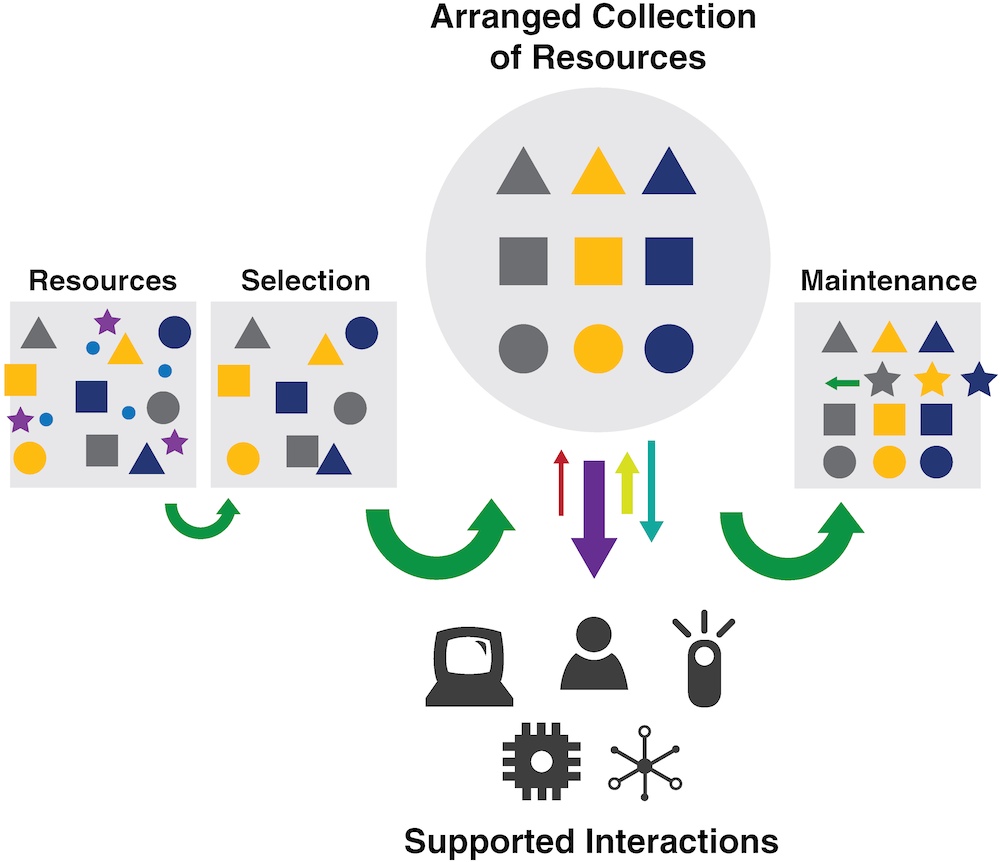25 Introduction (III)
There are four activities that occur naturally in every organizing system; how explicit they are depend on the scope, the breadth or variety of the resources, and the scale, the number of resources that the organizing system encompasses. Consider the routine, everyday task of managing your wardrobe. When you organize your clothes closet, you are unlikely to write a formal selection policy that specifies what things go in the closet. You do not consciously itemize and prioritize the ways you expect to search for and locate things, and you are unlikely to consider explicitly the organizing principles that you use to arrange them. From time to time you will put things back in order and discard things you no longer wear, but you probably will not schedule this as a regular activity on your calendar.
Your clothes closet is an organizing system; defined as “an intentionally arranged collection of resources and the interactions they support.” As such, it exposes these four highly interrelated and iterative activities:
- Selecting
-
Determining the scope of the organizing system by specifying which resources should be included. (Should I hang up my sweaters in the clothes closet or put them in a dresser drawer in the bedroom?)
- Organizing
-
Specifying the principles or rules that will be followed to arrange the resources. (Should I sort my shirts by color, sleeve type, or season?)
- Designing resource-based interactions
-
Designing and implementing the actions, functions or services that make use of the resources. (Do I need storage places for clothes to be laundered? Should I have separate baskets for white and colors? Dry cleaning?)
- Maintaining
-
Managing and adapting the resources and the organization imposed on them as needed to support the interactions. (When is it time to straighten up the closet? What about mending? Should I toss out clothes based on wear and tear, how long I have owned them, or whether I am tired of them? What about excess hangers?)
These activities are not entirely separable or sequential, and they can be informal for your clothes closet because its scope and scale are limited. In institutional organizing systems the activities and the inter-dependencies and iterations among them are more carefully managed and often highly formal.
For example, a data warehouse combines data from different sources like orders, sales, customers, inventory, and finance. Business analysts explore combinations and subsets of the data to find important patterns and relationships. The most important questions in the design and operation of the data warehouse can be arranged using the same activities as the clothes closet.
- Selecting
-
Which data sources should be included? How is their quality assessed? How much of the data is sampled? How are queries composed?
- Organizing
-
Which data formats and schemas will enable effective processing? Are needed transformations made at load time or query time?
- Designing resource-based interactions
-
What are the most important and frequent queries that need to be pre-configured?
- Maintaining
-
What governance policies and procedures are needed to satisfy retention, compliance, security, and privacy requirements?
Figure: Four Activities in all Organizing Systems. illustrates these four activities in all organizing systems, framing the depiction of the organizing and interaction design activities shown in Figure: An Organizing System. with the selection and maintenance activities that necessarily precede and follow them.

Four activities take place in all organizing systems: selection of resources for a collection; intentional organization of the resources; design and implementation of interactions with individual resources or with the collection, and; maintenance of the resources and the interactions over time.
These activities are deeply ingrained in academic curricula and professional practices, with domain-specific terms for their methods and results. Libraries and museums usually make their selection principles explicit in collection development policies. Adding a resource to a library collection is called acquisition, but adding to a museum collection is called accessioning. Documenting the contents of library and museum collections to organize them is called cataloging. Circulation is a central interaction in libraries, but because museum resources do not circulate the primary interactions for museum users are viewing or visiting the collection. Maintenance activities are usually described as preservation or curation.
In business information systems, selection of resources can involve data generation, capture, sampling, or extraction. Adding resources could involve loading, integration, or insertion. Schema development and data transformation are important organizing activities. Supported interactions could include querying, reporting, analysis, or visualization. Maintenance activities are often described as deletion, purging, data cleansing, governance, or compliance.
Domain-specific methods and vocabularies evolve over time to capture the complex and distinctive sets of experiences and practices of their respective disciplines. We can identify correspondences and overlapping meanings, but they are not synonyms or substitutes for each other. We propose more general terms like selection and maintenance, not as lowest common denominator replacements for these more specialized ones, but to facilitate communication and cooperation across the numerous disciplines that are concerned with organizing.
It might sound odd to describe the animals in a zoo as resources, to think of viewing a painting in a museum as an interaction, or to say that destroying information to comply with privacy regulations is maintenance. Taking a broader perspective on the activities in organizing systems so that we can identify best practices and patterns enables people with different backgrounds and working in different domains to understand and learn from each other.
Part of what a database administrator can learn from a museum curator follows from the rich associations the curator has accumulated around the concept of curation that are not available around the more general concept of maintenance. Without the shared concept of maintenance to bridge their disciplines, this learning could not take place.

